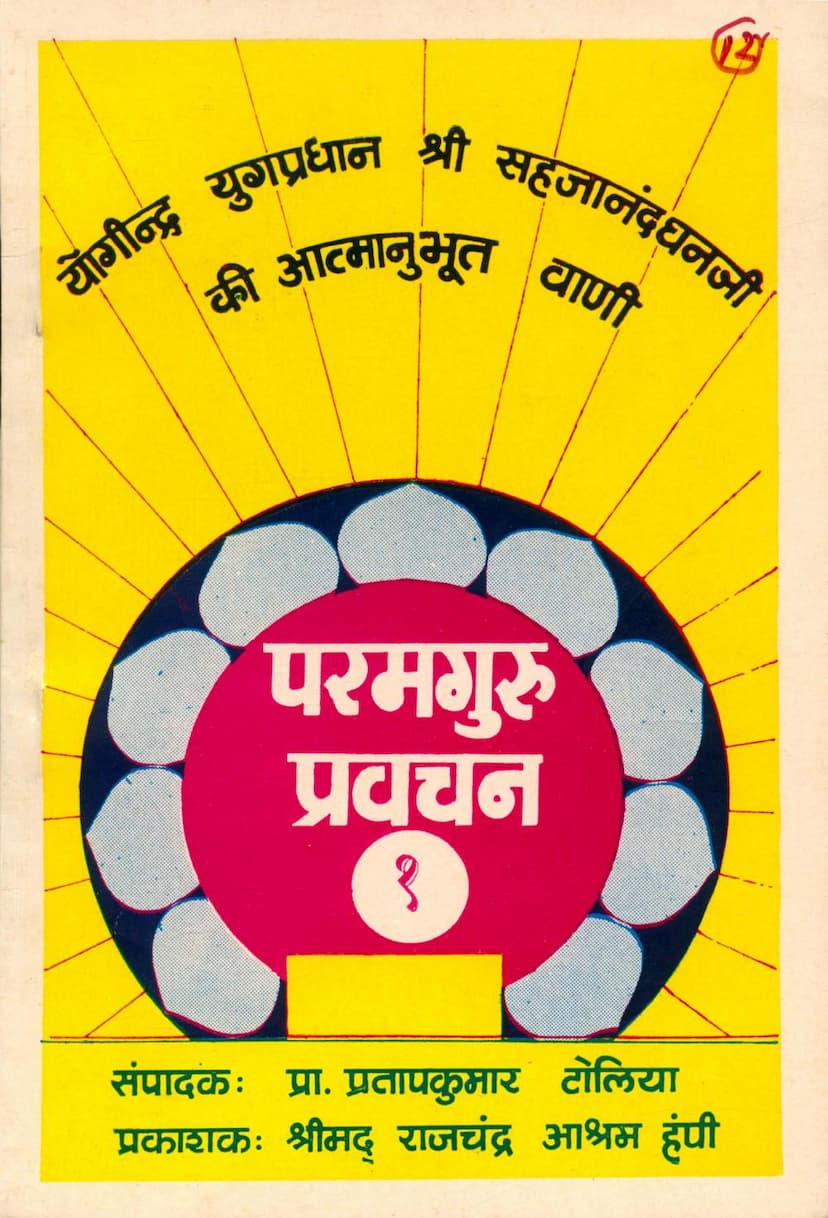Param Guru Pravachan 01
Added to library: September 2, 2025

Summary
Here is a comprehensive summary of the Jain text "Param Guru Pravachan 01: Paanch Samvay: Satpurusharth" by Pratap J Tolia, published by Shrimad Rajchandra Ashram, in English:
This book, "Param Guru Pravachan 01: Paanch Samvay: Satpurusharth," is a collection of spiritual discourses by the revered Yogindra Yugapradhan Shri Sahajanandghanji Maharaj (Bhadramuni). The lectures, originally recorded on tape, have been compiled and published by Shrimad Rajchandra Ashram, Hampi. The book is edited by Prof. Pratapkumar J. Tolia and Smt. Sumitra P. Tolia, and it is inspired and blessed by Pujya Atmagnani Mataji Shri Dhanadevi Ji. The publication aims to make the profound teachings of Shri Sahajanandghanji Maharaj accessible to a wider audience, including those outside Gujarat, hence the Gujarati language is presented in Devanagari script.
The core theme of this first volume, "Paanch Samvay: Satpurusharth," revolves around the concept of "Five Synchronicities for True Effort" and the crucial role of "Sophiological endeavor" or "True Spiritual Effort."
Key Concepts and Teachings:
-
The Five Synchronicities (Paanch Samvay): The teachings emphasize that achieving any significant goal, especially spiritual liberation (Atmasiddhi), requires the convergence of five specific factors:
- Kaal (Time): The opportune moment or the right timing.
- Swabhav (Nature/Disposition): The innate tendencies and one's own inherent nature.
- Niyati (Destiny/Decision/Determination): A firm resolve or a strong decision.
- Purvakrut (Past Deeds/Karma): The results of actions from previous lives.
- Purusharth (Effort/Endeavor): One's own conscious and dedicated spiritual exertion. The book stresses that without the harmonious interplay of all five, the desired outcome cannot be achieved.
-
The Importance of Determination (Nishchay): A strong, unwavering decision ("I must achieve self-realization in this life") is presented as the foundational step. This determination, or "Niyati," is crucial before other factors can fall into place. Examples of business success due to firm decisions are given, illustrating the power of such resolve.
-
Aligning with One's True Nature (Swabhav): True effort involves aligning one's internal states and actions with one's true self (Atma). This means redirecting the outward flow of consciousness and energy towards the inner source. The analogy of electricity from a cell powering a bulb is used to explain how inner consciousness manifests outwardly through the senses. The essence is to draw this energy back to its origin.
-
The Distinction Between External Circumstances and Internal States: The teachings highlight that external circumstances (per-dravya, per-kshetra, per-bhav) are not the true obstacles. The real impediment lies in one's own vibhav-bhavas (unfavorable internal states) that arise in response to external conditions. By transforming these internal states to align with one's true nature (swabhav), external challenges lose their power.
-
The Power of Inner Focus (Antarlaksh): The practice of keeping one's attention focused inwards, on the true self (Atma), is paramount. This "Antarlaksh" is compared to the precise aiming required for a target. Without this inner focus, external actions, even devotional practices or austerities, are deemed ineffective in achieving true spiritual liberation. The analogy of churning water to get butter is used to illustrate the futility of external practices without inner awareness.
-
Consciousness Science (Chaitanyavigyaan): This refers to the practical application of one's inner consciousness (Chaitanya) by drawing it back to its source. When one's consciousness operates from its true nature (swakshetra, swakal, swabhav), external difficulties cannot disturb the inner state.
-
True Effort vs. Fate: While acknowledging the role of past karma (purvakrut), the book strongly advocates for Purusharth (conscious effort) as the primary driver. Fate (bhagya) is seen as a consequence of past efforts, and relying solely on it is discouraged. True effort involves actively engaging with circumstances, not passively accepting them. The analogy of pushing a cart uphill with an engine demonstrates how strong effort can overcome limitations.
-
The Nature of the Self (Atma): The Atma is described as the "driver" of the physical body ("motor"). It is pure consciousness, ever-present, and not bound by physical limitations. The teachings emphasize recognizing the self as distinct from the body, senses, and external relationships.
-
The Illusion of the World (Jagad): The material world and its phenomena are presented as transient and illusory, akin to a dream or a transformation of matter. Relationships and attachments are also considered impermanent. True liberation comes from recognizing this illusory nature and detaching from it.
-
The Meaning of Dharma: Dharma is defined as the "capture of the mind" (Manani Dharkpad). It is the state of being aligned with one's true self, independent of external actions or affiliations. Without this inner awareness, external religious practices are considered mere rituals.
-
Effort in Daily Life: The teachings stress that spiritual realization can be attained even while living in the world, engaging in business, or fulfilling worldly duties. The example of Shrimad Rajchandraji is cited, who maintained a state of "Sahaj Samadhi" (natural equilibrium) even amidst his bustling commercial and intellectual life. The key is to remain aware of the true self amidst all activities.
-
The Distinction Between Merit (Punya) and True Religion (Dharma): Punya is likened to golden shackles – desirable but still a form of bondage. True Dharma, on the other hand, is freedom from both positive (punya) and negative (papa) karmic bondage, a state of natural equanimity.
-
The Key to Success: The book concludes by reiterating that continuous self-awareness (Swarup Jagruti) is the key to true effort and spiritual success. This constant remembrance of the self, "I am the Atma," is the "key" to achieving the state of Satpurusharth.
In essence, "Param Guru Pravachan 01: Paanch Samvay: Satpurusharth" serves as a guide to understanding the fundamental principles of Jain spiritual practice, emphasizing the power of inner resolve, self-awareness, and consistent effort in realizing the true nature of the soul. It encourages seekers to shift their focus from external observances to internal transformation for true spiritual progress.